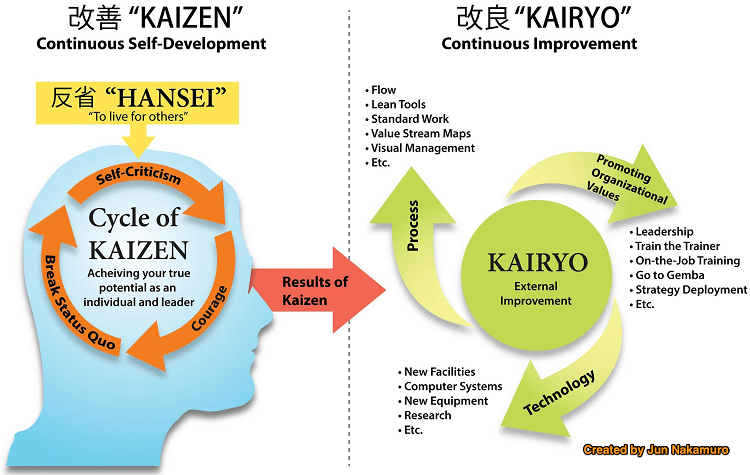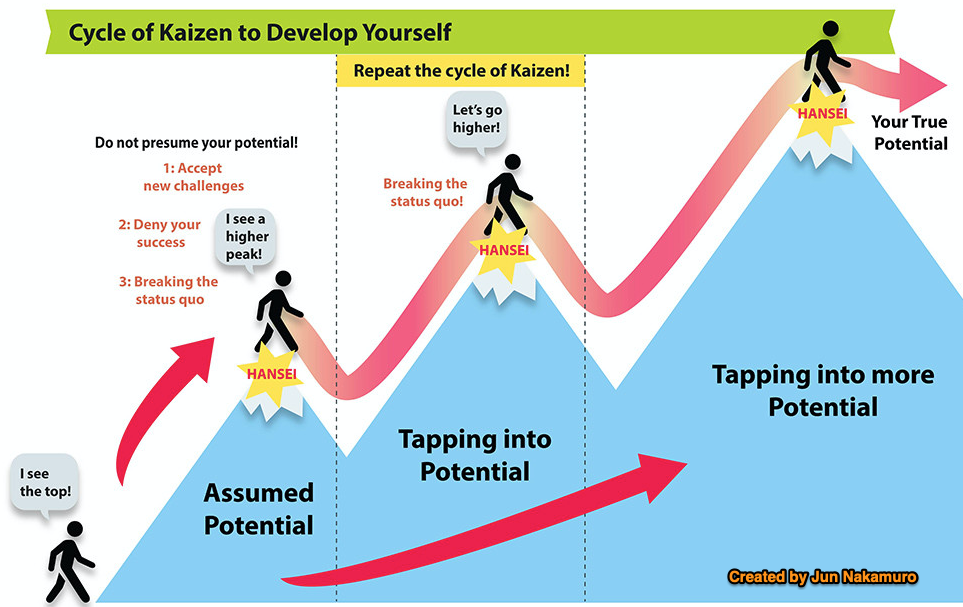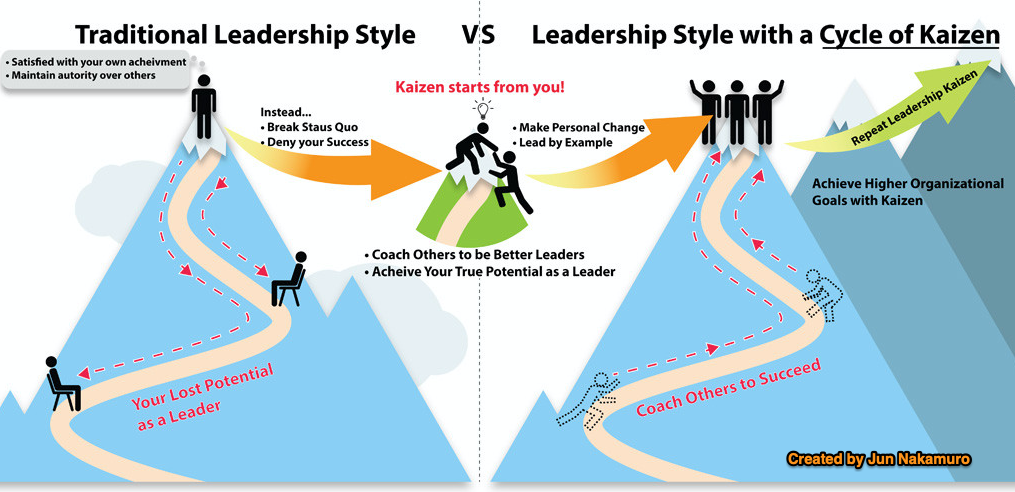In this sea of content, it becomes much harder to find something authentic and valuable. We genuinely believe that the following post meets these requirements, and we are happy to share it with you.
Special thanks to the author Jun Nakamuro for letting us republish this article on our blog.
Japanese improvement techniques have been emulated across the globe for decades, and none carries more cultural weight than the theory of Kaizen. When I expose Western leaders to Lean practices in Japan, they often express that they have come away with a better understanding of "true Kaizen." They are clearly witnessing something in Japanese society that is not carried over in mainstream guides to Lean.
Despite what you may have been told, Kaizen does not just mean "continuous improvement." "Change for the better" is a part of Kaizen, to be sure, but there is much more to it. Many experts might show you the kanji (Japanese letters “改善”) that make up the word Kaizen and explain their composition and history, but this would be a lesson in etymology rather than an exploration of what Kaizen actually means.
I feel that an over-emphasis of the word "Kaizen" has distracted people from the theory of Kaizen. The theory of Kaizen cannot be contained in a single phrase, so instead, I will walk you through what it means to those who have experienced its benefits, myself included.
The Lost Meaning of Kaizen
Over the years I have received ongoing training with Hitoshi Yamada, who was the foremost protégé of Taiichi Ohno. Mr. Ohno applied the theory of Kaizen to help Toyota reach unprecedented levels of success. Toyota is just one case study that illustrates the power of Kaizen. I have the honor of carrying on Ohno's mission and legacy with full approval from his protégé.
"Continuous improvement" is not the definition of Kaizen but rather the result of Kaizen. The literal translation of "continuous improvement" in Japanese is “Kairyo 改良.” This is something you achieve externally through material and financial investments or relying on the techniques of others to solve your problems.
Kaizen is more personal, and it occurs within your own mind. Kaizen could be better translated as "continuous self-development." Here we can see a clear distinction between the two concepts: improvement and self-development. This is why, even in North America, Toyota employees often say "Kaizen" in its original Japanese rather than attempting to translate it into English.
Continuous improvement is an external force, and Kaizen is an internal force. New equipment, facilities, or other investments in methodologies might be improvements, but they are not Kaizen. Kaizen is a process in your mind, of reviving your innate potential as a human being by developing strong willpower to break the status quo.
Before this definition of Kaizen starts to sound like ambiguous mysticism, let's look at how Kaizen is actually achieved. This is not a simple matter of positive thinking; in some ways, it's quite the opposite. In order to achieve Kaizen, you have to hold yourself accountable and acknowledge your struggles as well as the negative emotions they bring about. This is far from defeatism; it's a starting point for change. Without accepting this internal struggle, you will not have the motivation to avoid defeat in the future.
Kaizen as Self-Development
It is common in Japanese schools and businesses for people to gather at the end of the day to celebrate success but also to recognize areas that can be improved, even if everything seems to have gone very well. This practice is known as “hansei 反省.” It is the practice of self-criticism that fuels Kaizen. Hansei inspires you to always see room for self-development.
In an interview with The Red Bulletin, mountaineer Dani Arnold discussed the importance of self-criticism in his path to success. The mindset that he describes is a great example of hansei in action. In fact, the image of a mountain brings to mind a good analogy.
Imagine you have just reached the summit of a very tall mountain. Simple positive thinking would lead you to see this as success. But what if there are higher peaks beyond the summit that you only discover once you get there? Do you have the courage to accept this new challenge, or will you remain satisfied with the status quo?
In order to reach the next peak, you must first acknowledge that you have not achieved the highest goal. Simple positive thinking, without self-criticism, can lead to stagnation of self-being. Only through self-criticism will you find the motivation to push yourself further. This is why hansei is such an important part of the Kaizen process. It is a simple science (repeatability.)
The hansei process is not easy, and it is not supposed to be. You will surely feel disappointed and clueless if your actions yield no results. You might feel angry, jealous of others, and ashamed of yourself. While these are negative emotions, experiencing them has positive consequences. It is the negative emotions that provide the motivation to improve. These emotions are necessary for Kaizen. Kaizen is a matter of leveraging these human instincts to drive you to try harder and get better results.
In order to be sustained, Kaizen must be a continuous cycle. Without the motivation to accept your own failures, the cycle will grind to a halt. Compliments and positive thinking are a day-to-day necessity, but you need to taste bitterness to appreciate sweetness. Like a muscle, your professional success cannot grow without some measure of pain.
When we feel pain, our survival instinct is triggered, and we do everything we can to avoid feeling that pain again. And yet, if we never felt pain, this instinct would never kick in. Using self-criticism as a starting point for reaching your greatest potential is not just an ideal; it is a mechanism that is built into nature.
Let's assume you have scaled the tallest mountain in the universe. Is there still room for self-criticism? You may have reached the peak of the mountain on your own and become the top leader, but when you look down the mountain range, your subordinates are still struggling to scale different peaks. You have not achieved your true potential as a leader until you help everyone else join you at the top of the highest mountain. You may believe that you have reached the peak of personal development, but there is a greater goal to reach for developing yourself as a leader.
As a leader, it is always possible to do better if you have the courage to deny your own success and hold yourself accountable for the struggles of others, even when you can clearly see that these problems are not your fault. As a leader, you must always accept the struggles of others as your own in order to keep developing a strong desire to help your team. This is how you truly develop yourself as a leader: by helping others join you at the top.
Kaizen is not a target; it is how you challenge your mindset. You must be courageous to reveal and accept the insecurities of yourself and others, but the energy generated from this practice is what fuels your development as a human being and a leader. Start by denying the satisfaction of your achievements, and challenge yourself to reach the higher goals that you can see on the horizon.
The article was originally published here.
About the Author:
Jun Nakamuro is the foremost expert in organizational design and re-design through applied knowledge. His top-level ability is exemplified in their leadership, quality work, and exceptional results. Mr. Nakamuro has received ongoing training with Hitoshi Yamada, who was the foremost protégé of Taiichi Ohno /considered to be the father of the Toyota Production System/.

Pavel Naydenov
Marketing Professional | Kanban & PPM Ops Certified
Pavel is a natural-born optimist with 10+ years of experience in the marketing field. By leveraging Kanban, Lean, and Agile practices for years, he drives brand growth and engagement through data-driven marketing strategies. He believes every message should express the fundamental values of a brand, and if delivered positively, it can change the course of its existence.






